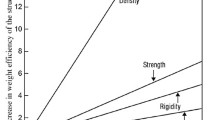Abstract
Modern passenger and cargo planes are designed for long-term service of at least thirty years. Stability of the properties of the structural materials used in planes over their entire life is a necessary requirement. The main structural material for a passenger plane is high-strength aluminum alloys, of which are Al−Li alloys the most promising. The present paper is devoted to Al−Li alloys and concerns the nature of the thermal stability, its dependence on various structural factors, and possible ways of stabilizing the properties.
Similar content being viewed by others
References
V. G. Davydov, “Metal science and technological studies of aluminum-lithium alloys today,”Tekhnol. Legkikh Splavov, No. 4, 15–25 (1996).
V. N. Anan'ev, B. L. Ber, V. G. Davydov, et al., “Structural aspects of the instability of properties of aluminum-lithium alloys under long-term low-termperature heating,”Tsvetn. Metally, No. 7, 59–63 (1997).
O. A. Setyukov, N. V. Ruch'eva, S. A. Karimova, et al., “Effect of technological and operating heating on the structure and mechanical and corrosion properties of shapes made of alloy 1420,”Tekhnol. Legkikh Splavov, Nos. 3–4, 13–18 (1994).
Registration Record of Aluminum Association Designations and Chemical Composition Limits for Wrought Aluminum and Wrought Aluminum Alloys, The Aluminum Association, 900 19th Street N. W., Washington, D. C. 20006, Revised: December 1993, Supersedes: February 1991.
G. L. Shneider, L. M. Sheveleva, Yu. V. Shchelbanin, and Yu. P. Plotnikov, “Controlled cooling of preforms made of alloy 1420,”Tekhnol. Legkikh Splavov, No. 4, 29–30 (1992).
G. L. Shneider, L. M. Sheveleva, and E. Ya. Kaputkin, “Phase transformations in heat treatment of alloy 1420,”Tsvet. Metally, No. 2, 49–52 (1994).
G. L. Shneider, “Phase transformations in heat treatment of Al−Li alloys and optimization of service properties of semifinished products made of these alloys,”Metalloved. Term. Obrab. Met., No. 1, 24–30 (1998).
G. L. Shneider, “Some special features of fracture of large semifinished products made of aluminum alloys,”Metalloved. Term. Obrab. Met., No. 3, 2–7 (1997).
T. D. Rostova, “Some special features of fracture of rolled semifinished products made of Al−Li alloys,”Tekhnol. Legkikh Splavov, No. 1, 40–44 (1996).
V. V. Zakharov and T. D. Rostova, “Role of shear bands in sheets of aluminum-lithium alloys,”Tekhnol. Legkikh Splavov, No. 5, 35–40 (1996).
Author information
Authors and Affiliations
Additional information
Translated from Metallovedenie i Termicheskaya Obrabotka Metallov, No. 1, pp. 35–39, January, 1999.
Rights and permissions
About this article
Cite this article
Zakharov, V.V. Thermal stability of Al−Li alloys. Met Sci Heat Treat 41, 39–43 (1999). https://doi.org/10.1007/BF02466271
Issue Date:
DOI: https://doi.org/10.1007/BF02466271




